Perhaps you have noticed your hot tub sides and bottom are feeling a bit slimy. It’s usually caused by something called “biofilm”.
In this article, we’ll go over the possible causes of biofilm and slimy feeling in hot tubs and spas. As well as what we can do about it, and the best chemicals to clean off the biofilm slime.
The best way to fix a slimy hot tub and remove biofilm formation is to use a combination of mechanically removing and treating it with an enzyme chemical. To prevent reoccurrence, Biofilm must be removed from visible surfaces and also the internal components of your hot tub, such as the plumbing lines.
Before we move on to tackling our slimy hot tub problem, let’s first take a look at what biofilm is precisely so that you can be on the lookout for any potential issues before they escalate in the future.
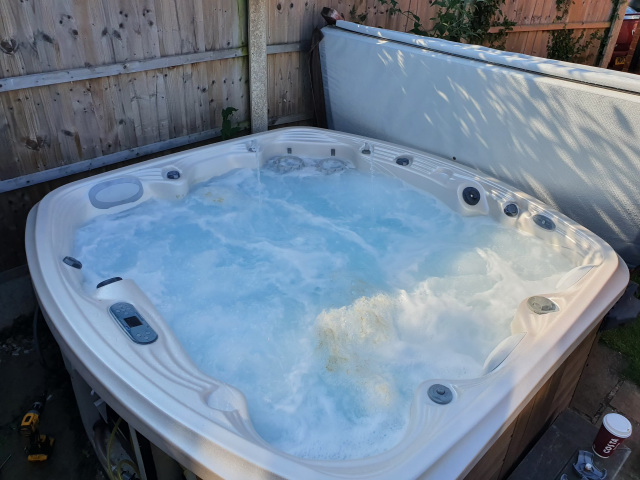
Article Contents
What Causes Hot Tub Slime?
Here are the most common causes of having a slimy hot tub. The list is in no particular order:
1. Biofilm Producing Bacteria Present in the Hot Tub
Probably the most common reason for a slimy hot tub you’re going to come across is the fact that there are biofilm bacteria present in the tub.
Biofilm can appear on hot tub walls, in the hot tub piping, and in the filter. Biofilms are naturally slippery on surfaces, so you may find it difficult to even enter your hot tub before trying to soak in it.
Causes of biofilm are often a product of the environment and not necessarily something caused by the spa owner. Once they are attached and established, they can be difficult to kill and will keep multiplying until permanently removed.
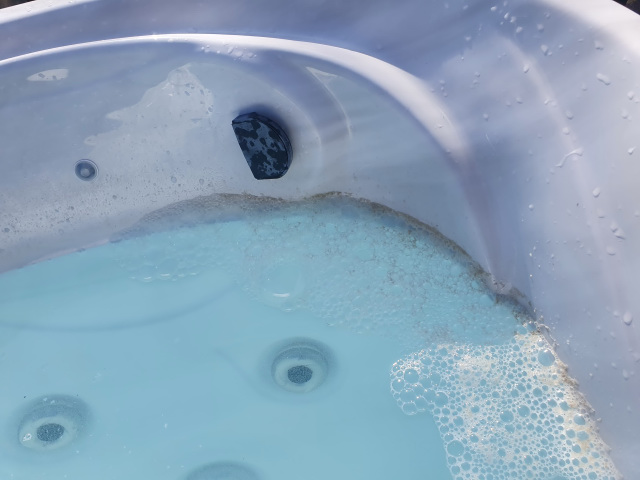
2. There’s Mold or Algae Present
Another relatively common culprit of a slimy hot tub is the fact that there’s mold or algae present in the tub. Luckily, they’re more noticeable than biofilm and also easier to remove.
Similar to biofilm-producing bacteria, mold, algae, and mildew grow in the water in your tub if the water’s been inadequately treated (by sanitizing, shocking, etc.). As long as you’re regularly keeping the water clean, you shouldn’t be seeing these things in the hot tub.
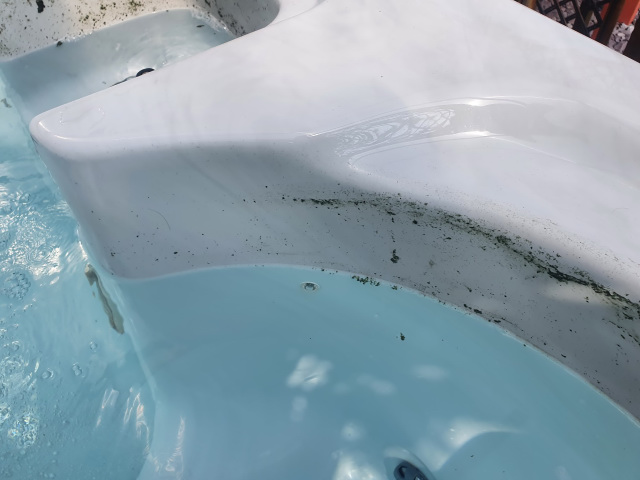
3. There’s a Buildup of Scale
If the pH in your hot tub is too high due to reasons such as inadequate monitoring, this can result in a mineral buildup which not only makes the water look unappealing but also makes sitting in the hot tub an unpleasant experience.
4. Chemicals Out of Balance
Sometimes, the chemicals themselves can cause the water to feel slimy, especially if those chemicals happen to raise pH and caused the water to become too alkaline. In a hot tub, it’s important to keep the pH between 7.4 and 7.6. Sanitizers tend to work best in this pH range.
What is Biofilm?
In this article, we’ll focus on biofilm, which is one of the most common causes of a slimy hot tub.
Biofilm is a substance created by many types of bacteria that acts as a protective barrier, preventing the bacteria from getting exposed to the harsh outside environment.
Once a few bacteria find a decent place to grow, they’ll attach themselves to that area and multiply, eventually forming a colony. To prevent the colony from breaking apart, they’ll secrete a slimy substance that eventually forms this nearly impenetrable barrier known as a biofilm.

What Does Biofilm Look Like?
Biofilms can take on all types of colors depending on the bacteria that are producing them, but the ones you’ll find in your hot tub will typically appear as a greenish-white sticky substance by itself that can also appear as a white coating on your hot tub walls. They can also appear as pink slime. Regardless of the color, most biofilms share the common trait of appearing as a viscous, shiny feeling film.
The mineral deposit can also enter the internals of your hot tub, which can damage components such as filters and pipe, as well as the hot tub itself.
Is Hot Tub Slime/Biofilm Dangerous for Your Health?
Being exposed to biofilm (or the bacteria that’s causing it) is certainly not the end of the world, but it can lead to some potential health side effects which you should be aware of, as it can worsen if you’re not careful.
Here are some of the dangers of biofilm and hot tub slime:
- Causes rashes on swimmers
- Can lead to hot tub lung
- Raises the hot tub pH
- Can cause dangerous bacterial growth
- Increases chlorine or bromine demand
Because biofilm breaks down chlorine and bromine, it indirectly raises the pH of the water. And higher pH levels mean sanitizers are less effective.
In addition, coming into contact with biofilm can cause a variety of symptoms such as rashes, itchiness, and tender skin, all of which usually disappear within one to two days.
The biofilm in the water can also become aerated and airborne by the jets. This makes it possible to breathe them in or come into contact with them, in which case you might experience ear, eye, or respiratory infections or dangerous conditions such as hot tub lung (HTL).
Hot tub lung is caused by breathing in air that contains a class of bacteria called, non-tuberculous mycobacterium. It’s definitely something you don’t want.
In extreme cases, you may develop UTIs or Legionella if you stayed in the biofilm-infested water for too long. There’s also a chance for you to become infected with folliculitis, a bacteria that thrives in unmaintained warm hot tub water. If you experience any of these, you’ll want to pay close attention and potentially visit your doctor if symptoms worsen.
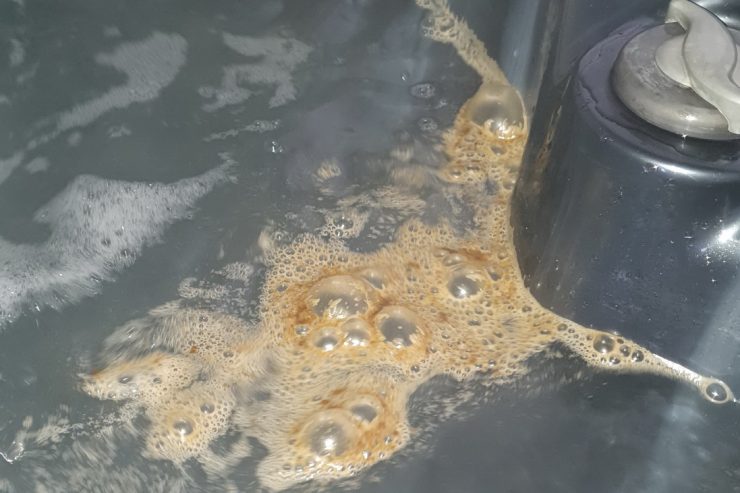
Related Reading: How Long Should I Run My Hot Tub Filter?
How to Remove Hot Tub Biofilm (Slime)
Biofilm often requires a three-step approach to remove it. In addition to the biofilm slime being on the outer shell of your hot tub, it is usually present inside the pipes and lines and could be in the filter and heater too.
Follow these steps to remove biofilm:
- Chemically treat with enzymes to remove from pipes and internal parts.
- Clean or replace the filter
- Drain then mechanically clean the hot tub shell
Chemicals to Remove Biofilm
To kill and get rid of biofilm from a hot tub or spa, you’ll need to use an enzyme cleaner as well as scrubbing. The enzyme will get into all the areas you can’t reach, such as the pipes.
You may be tempted to skip this and just scrub your hot tub. Don’t do that, it will come back quickly. It needs to be removed from the pipes.
Will Shock, Chlorine, or Bromine Kill Biofilm?
You may be thinking that your usual sanitizer (chlorine or bromine) or spa shock will be enough to get rid of the biofilm. Unfortunately, it’s not.
Biofilm is highly resistant to chlorine, bromine, and shock products. It’s because it develops a protective layer. You’ll need to use an enzyme-based product to get rid of it.
Here are the best chemicals for effectively removing biofilm from your hot tub in just under $50:
1. Oh Yuk Hot Tub Cleaner
- Improves water clarity
- Removes contaminants
- Improves filtration
- Very quick to work (works within an hour)
- Breaks down biofilm
- Removes other contaminants invisible to the naked eye
- Depending on the situation, not as effective as some of the other products solely focused on biofilms
2. Ahh-Some Hot Tub Cleaner
- Eliminates harmful contaminants
- Super concentrated gel product
- Decontaminates plumbing system
- Especially effective against biofilms
- Environmentally friendly
- Causes no damage to any hot tub surface
- It may take several doses to clear up a severe biofilm issue
Step-by-Step Guide to Remove Biofilm Slime
Here’s a step-by-step guide to the process behind removing the biofilm from your hot tub. Keep in mind that both of the products mentioned earlier will work.
1. Remove Any Slime From the Surface
Use a skimmer net or oil-absorbing sponge to remove any slime you can see floating on the water’s surface. Clean the net after each pass if necessary.
2. Use a Spa Enzyme Cleaner to Break Down the Biofilm
Use your preferred choice of biofilm cleaner to break down the biofilms (don’t use sanitizer). Add the appropriate amount of chemical to the water and run the pump for an hour to help disperse it. You may have to cleaner overnight – but follow the directions on the pack.
This will allow the chemical ample time to destroy the biofilms in the hot tub shell as well as in the pipes and filtration system.
3. Clean Out/Replace Your Filter
At the same time, you need to clean your filter. You need to make sure you clean everything to prevent a reoccurrence.
After removing the filter from its housing, use a product like this to soak your filter overnight:
- Improves the efficiency and life of the filter
- Includes spa cleaning chemicals
- Removes oil, grease, dirt and soap
If the filter is old or you’ve already cleaned it several times, replace it.
4. Drain and Wipe Down Hot Tub
After the cleaner has done its job, it’s time to turn off the power, drain the hot tub, and scrub or wipe down all the surfaces with an all-purpose cleaner such as this one:
- Can be used on vinyl covers, fiberglass, and filters
- Safe to use on all surfaces
- Contains a unique blend of coconut oils
When you wipe everything, pay extra attention to the headrests and waterline. This is where you’ll find lots of the scum. Make sure you don’t forget to clean the hot tub cover.
5. Refill, Test, and Balance Chemical Levels
Rinse off your tub with a hose after cleaning. Now it’s time to refill the water and add the chemicals. Start by balancing the alkalinity and pH, then add the sanitizer.
It’s important to make sure the chemical levels in your hot tub water are balanced before you use it again. Do this using a test strip, liquid testing kit, or digital testing meter.
You’ll be looking for:
- pH (7.4-7.6 recommended)
- Total alkalinity (80-120 ppm recommended)
- Calcium hardness (175-250 ppm recommended)
- Sanitizer: chlorine: 1-3 ppm or bromine: 3-5 ppm
Do You Need to Drain to Remove Biofilm?
If you use the above method, you’ll have to drain your hot tub after you’ve added in the cleaner and it’s done its work. You may also have to drain it a second time after you’ve rinsed everything off to kill off any potentially remaining bacteria.
On the other hand, you may try using vinegar. Although, if you want a thorough clean, drain your hot tub. You will need to do this every few months anyway.
Will Shocking Remove Biofilm (Hot Tub Slime)?
Shocking will reactivate any sanitizers in the water by giving it a high dose of chlorine or non-chlorine chemicals, thus increasing the amount of free chlorine in the water and helping prevent a future biofilm occurrence. However, it will not kill any biofilm that is already present in the water.
Does Vinegar Kill Biofilm?
As an alternative method, vinegar kills biofilm and can save you the trouble of having to drain your hot tub afterward. However, the type of vinegar you use is very important and the steps overall can be a bit more complicated than the method we discussed earlier.
Related Reading: How to Lower Hot Tub pH Naturally (Using Vinegar)
Tips to Prevent Hot Tubs From Going Slimy
Balance the Chemicals in the Water
Test and adjust the chemical levels in the water every week to make sure the sanitizers continue working properly. Without the right concentration of sanitizers, there is a good chance the biofilm-producing bacteria will resurface.
Shock Your Hot Tub Water Regularly
Shocking the water every week can prevent the bacteria from colonizing the plumbing system. A good idea is to add non-chlorine shock after each use of the hot tub to help the sanitizers work more efficiently.
Clean the Filters Regularly
Maintaining the cleanliness of the filters is essential for water clarity. The filters should be rinsed with water every week, rinsed with chemicals every month, and chemically soaked on a three-month basis.
Keep the Water in the Hot Tub Circulating
Keeping the water circulating helps prevent bacteria from getting the opportunity to colonize. Leaving the jets open is a good way of going about this.
Cover Your Hot Tub When Not in Use
Covering your hot tub with an insulated cover when you’re not using it can prevent any debris or dirt from getting into the water and disrupting the chemical balance.
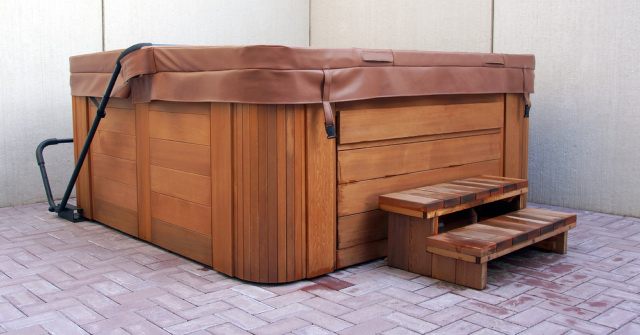
Use an Enzyme Cleaner
To maintain your water and reduce the need to deep clean your hot tub, you can use an enzyme cleaner every month or so.
Final Thoughts
The most important takeaways from this article are that you can use either a biofilm cleaning solution or vinegar to fix your slimy hot tub issue due to biofilm buildup. It may seem like a lot of information to process, but just remember to read over the prevention tips and you’re guaranteed to save yourself a ton of hassle in the future.





